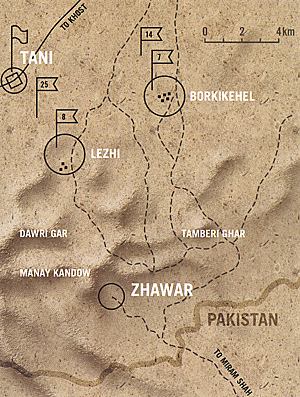
THE ASSAULT
In February, 1986, the Democratic Republic of Afghanistan (DRA) Ministry of Defense and their Soviet patrons decided to destroy Zhawar. Zhawar was a Mujahideen logistics transfer base in Paktia Province in the eastern part of Afghanistan. It was located four kilometers from the Pakistan border and 15 kilometers from the major Pakistani forward supply base at Miram Shah.
Zhawar was a Mujahideen training center and a major combat base for supply, training and staging. The base was located inside a canyon surrounded by Sodyaki Ghar and Moghulgi Ghar mountains. The canyon opens to the southeast facing Pakistan.
The Mujahideen had built at least 11 major tunnels into the south-east facing ridge of Sodyaki Ghar Mountain. Some tunnels reached 500 meters and contained a hotel, a mosque, arms depots and repair shops, a garage, a medical point, a radio center and a kitchen. A gasoline generator provided power to the tunnels and the hotel's video player.
Defending this key logistical base was the "Zhawar Regiment", some 400 strong that were permanently based there. This regiment was primarily responsible for logistics and for supplying the Islamic Party (HIK) groups in other provinces of Afghanistan. The regiment was not fully equipped for combat, but was a credible combat force.
The regiment had a Soviet D30 122mm howitzer, some six-barrel Chinese BM-12 multiple rocket launchers (MRL), three 30mm Oerlikon AA, numerous 12.7mm machine guns, SA-7 SAMs and 13 Blowpipe. Some indicate a Stinger SAM was present. An air defense company defended Zhawar with five ZPU-1 and four ZPU-2 14.5 turn antiaircraft heavy machine guns. These were positioned on high ground around the base. All ground approaches were protected by AT mines, mortars, anti- tank RCL weapons and the infamous RPG-7. Many positions had communications linked with telephone or walkie talkie radios.
The approaches to the base were the responsibility of the National Islamic Front of Afghanistan (NIFA), the Islamic Revolutionary Movement (IRMA), and two Islamic Party factions (HIH and HIK). These amounted to another 400 or so men. Twenty percent of all the Mujahideen supplies came through the Zhawar. The overall Mujahideen commander of Paktia Province, including Zhawar base, was Jalaluddin Haqani, a tall, black-bearded, 50 years old.
THE PLAN
The Soviets felt that the DRA should now take the leading combat role against the Mujahideen and urged the DRA to again attack Zhawar. This urging was to show how a DRA/Soviet planned offensive could be a success after the dismal failure of an earlier DRA Zhawar attack in September 1985. The DRA plan was classic on paper: DRA ground troops would attack from Tani and Borkikehel, both south of Khost. Artillery units would be based near Lezhi.
As this occurred, the 38th Commando Air Assault brigade (some 400-500 Soviet/DRAmen) would descend from their Mi- 8s atop of the 2180 meter high Manay Kandow. The thought was to trap the Mujahideens blocking the ground forces, and open a corridor to Zhawar.
The general of the Soviet Army, Varrenikov, gave his blessing and the high command developed the plan for a combined operation. The plan would commit 54 under- strength DRA maneuver battalions (these battalions averaged 300-400 men) plus DRA artillery and 32 Mi-8s to the assault (plus Mi- 24s and Su-25s). The 7th Infantry Division ( 2,d Army Corps) moved from Kandahar, the 8th Infantry Division (1st Army Corps) moved from Kabul, the 14th Infantry Division (3rd Army Corps) move from Gazni, the 25th Infantry Division Ord Army Corps)moved from Khost, the 38th Commando Brigade, and the 666th Air Assault Regiment "Commando" (3rd Army Corps) from Khost were committed.
These units came under the 3' Afghan Army Corps, under General-Major Mohammad Asef Delavar. His Soviet adviser was Deputy to the Senior Military Adviser for Combat, General-Major V. G. Trofimenko.
The eastern combat group was comprised of the 7th and 14th Infantry Divisions and the 666th Air Assault Regiment. The western combat group consisted of the 8 h and 25th Infantry Divisions. The commando group had little, if any, experience in air assault missions, and the first lift was scheduled to go in before sunrise as the ground assault began.
The Soviet Nadir Cataclysm at Zhawar Afghanistan: April 1986
- Assault and Plan
Cataclysm and Into the Hornet's Nest
Consequences and a Second Attempt
The End at Zhawar
Orders of Battle
Back to Table of Contents -- Against the Odds vol. 1 no. 3
Back to Against the Odds List of Issues
Back to MagWeb Magazine List
© Copyright 2002 by LPS.
This article appears in MagWeb.com (Magazine Web) on the Internet World Wide Web.
Other articles from military history and related magazines are available at http://www.magweb.com
* Buy this back issue or subscribe to Against the Odds direct from LPS.
